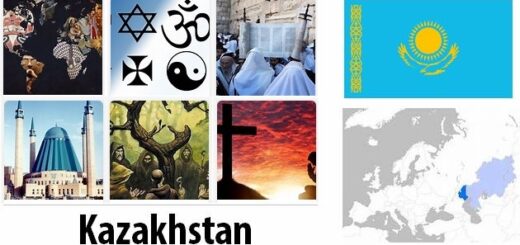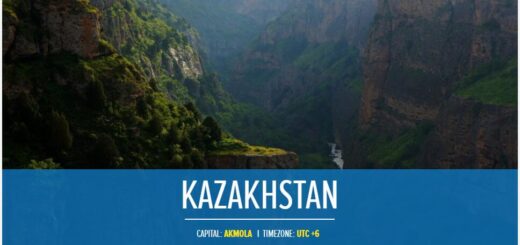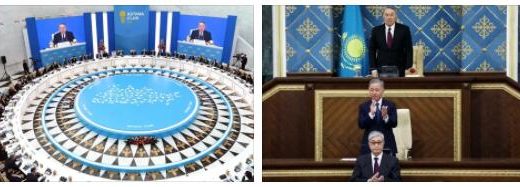Kazakhstan Overview
GENERAL
Official name of the state
Republic of Kazakhstan.
Capital
Astana.
Geography
As a country located in Asia according to a2zgov, Kazakhstan, the second largest member state of the Commonwealth of Independent States, borders the Russian Federation to the north and west, the Caspian Sea to the southwest, Kyrgyzstan, Turkmenistan and Uzbekistan to the south and China to the east. 90% of the country consists of steppe, the sand massifs of Karakum and the vast desert of Kisilkum. In the southeast, the mighty mountains of the Tienschan and Alatau characterize the landscape, in the east the foothills of the Altai Mountains. The dried up Aral Sea was one of the largest bodies of water in the country with the Balkhash Sea. Lake Balkhash is also increasingly drying up.
Government
Presidential republic since 1991. New constitution from 1995, last change in 2007. According to the constitution, the president is elected every five years. Bicameral parliament: lower house (Majlis) with 107 members and senate. Since 1991 independent state of the CIS. Member of the OSCE and the UN.
Head of state
Nursultan A. Nazarbayev, since 1990.
Head of government
Bakytzhan Sagintayev, since September 2016.
Electricity
220 V, 50 Hz. Round, 2-pin connector.
LANGUAGE
Overview
The official languages are Russian and Kazakh, one of the Turkic languages. According to government decisions, the Russian Cyrillic alphabet is to be replaced by the Turkish version of the Latin alphabet. So far, however, the Cyrillic alphabet is still generally used. The city dwellers and the people in the north of the country speak Russian, whereas the rural population partly only speaks Kazakh.
Turkish is widespread, and occasionally Ukrainian, Uyghur, Kyrgyz, Tatar or Uzbek are also spoken. The young population is also increasingly learning English, but the language is still not widely used. Tour guides usually speak English. Knowledge of Russian has great advantages, on the one hand to get into conversation with the locals, on the other hand because without language skills one is immediately recognized as a foreigner and often has to pay higher prices.
Idioms
Helpful words in Kazakh:
- Goodbye = Сау болыңыз [Sau bolingis]
- Eight = сегіз [segis]
- Exit = шығу [shighu]
- Beer = сыра [syra]
- Please = Оқасы жоқ [Oqasi yoq]
- Thank you = Рахмет [Rakhmet]
- Tuesday = сейсенбі [seysenbi]
- Doctor = дәрігер [driger]
- Thursday = бейсенбі [beysenbi]
- Three = үш [ush]
- Entrance = кіру [kiru]
- One hundred = жүз [zүz]
- One = бір [bir]
- Friday = жұма [zұma]
- Five = бес [bes]
- Hello = Сәлем [Sälem]
- Hotel = қонақ үй [hotel]
- I don’t speak Kazakh. = Мен қазақша сөйлей алмаймын. [Men qasaqsha söyley almaymin.]
- Yes = иә [iä]
- My name is …?? =?? Менің атым [Mening atim…]
- Wednesday = сәрсенбі [särsenbi]
- Monday = дүйсенбі [duysenbi]
- No = жоқ [yoq]
- Nine = тоғыз [toghis]
- Saturday = сенбі [senbi]
- Six = алты [alti]
- Seven = жеті [yeti]
- Sunday = жексенбі [yeksenbi]
- Menu = жеті [asmərizi]
- Do you speak German / English? =
- Toilet = дәретхана [dərethana]
- Four = төрт [fools]
- Wine = шарап [sarap]
- How much does it cost …? =… қанша тұрады?[… qansha turadi?]
- Ten = он [on]
- Two = екі [eki]
PUBLIC HOLIDAYS
Annotation
Muslim holidays are observed according to the lunar calendar and can deviate from the dates given. Eid al-Adha lasts between 2-10 days, depending on the region.
CULINARY
Regional specialities
Typical Kazakh dishes include kasi, chushuk, suret and beshbarmak (made from horse meat or mutton). Shashlik (mutton, grilled over coal) and lepeschka (round, unleavened bread) are often sold on street corners. Plov is made from mutton, grated turnips and rice and is one of the national dishes of the Central Asian republics. Other mutton dishes like laghman and beshbarmak include thick noodles that are served with a spicy meat sauce. Manty (small noodle pockets with meat and vegetables), samsa (Spicy dumplings filled with meat or vegetables) and Tschiburekki (deep-fried dough cakes) are popular snacks.
useful information
Traditionally, most Kazakhs serve the most important guest (usually the elder) a boiled sheep’s head as a sign of respect. The guest cuts the head and distributes the pieces of meat first to the older guests, then to the children and then to the relatives. National custom forbids younger family members whose parents are still alive from cutting the sheep’s head. You have to pass the sheep’s head on to the other guests to cut.
Tip
Hotels and restaurants charge around 10% service. An extra tip is not expected, but it is welcomed. Taxis charge a fixed rate.
Regional drinks
Kazakh tea (or chai) is very popular. In the Tschai-Khana (tea houses), a national institution, visitors can taste this Kazakh specialty. Beer, vodka, brandy, and sparkling wine are available in many restaurants. The national drink is kumis, fermented mare’s milk.
Minimum age for consuming alcoholic beverages
In Kazakhstan you can drink alcohol from the age of 18.
CULTURE
Religion
70% of the Kazakh population are Muslims (mainly Sunnis), 26% are Christians. There is a Jewish minority (less than 0.5%).
Islam in Kazakhstan is liberal, Kazakhs never fervently express their religious feelings. Kazakhstan is a peripheral district of the Muslim world and a meeting point for Russian, Chinese and Central Asian cultures. Islam plays a minor role in politics and there are no significant Islamic political organizations in the country.
Social rules of conduct
General: Kazakhs are traditionally extremely hospitable. Sneezing and blowing your nose are considered unhygienic, especially at the table. As in many Asian countries, however, spitting out on the street is common practice.
Manners: The usual forms of courtesy should be observed. When greeting the guest, the host gives the guest both hands. Invitations to private homes are common, so you should always have a few favors on hand. For example, culinary or alcoholic specialties from the home country and illustrated books are popular. The children look forward to a few small sweets. In Kazakhstan, conversations always start with longer small talk before discussing the actual issue. This is especially true in the business field.
Clothing: Well-groomed, casual clothing is acceptable on the street, but knees and shoulders should be covered. A more elegant wardrobe is expected for a visit to the theater or an invitation to dinner. Short pants should only be worn on the sports field. When visiting a mosque, shoulders and knees must be covered, and women should also cover their hair. In the mosques, women follow their own rituals in a separate room.
Taking photos: It is forbidden by law to take photos of airports and military buildings and facilities. People should be asked before they are photographed.
Smoking: Smoking is prohibited in public spaces and on public transport.
Tipping: It is not customary to tip in Kazakhstan.
CLIMATE
Best travel time
Continental climate with cold winters (on average -10 ° C) and hot summers (25 ° -30 ° C, in some areas up to 40 ° C) in the north.
Desert climate in central and western Kazakhstan.
Humid continental climate in the south of the country.
Warmest month July, August in mountain regions.
The best travel times differ according to region and type of holiday: cultural travelers enjoy the most pleasant weather from April to June and from September to October. Alpine regions are best visited in June and August and winter holidaymakers get their money’s worth from January to March.
COUNTRY DATA
Area code +7 Area (sqkm) 2724900 Population 18157122 Population density (per sqkm) 7 Population in 2015 Member of the EU No main emergency number 103



